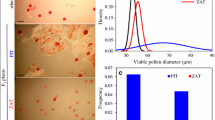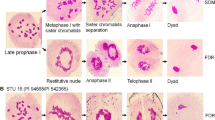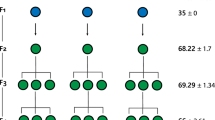Abstract
It is believed that unreduced gametes with somatic chromosome numbers play a predominant role in natural polyploidization. Allohexaploid bread wheat originated from spontaneous hybridization of Triticum turgidum L. with Aegilops tauschii Coss. Unreduced gametes originating via meiotic restitution, including first-division restitution (FDR) and single-division meiosis (SDM), are well documented in triploid F1 hybrids of T. turgidum with diploid Ae. tauschii (genomic constitution ABD, usually with 21 univalents in meiotic metaphase I). In this study, two T. turgidum lines known to carry genes for meiotic restitution were crossed to tetraploid Ae. tauschii. The resulting F1 hybrids (genomes ABDD), had seven pairs of homologous chromosomes and regularly formed 14 univalents and seven bivalents at metaphase I. Neither FDR nor SDM were observed. The distribution of chromosome numbers among progeny obtained by self pollination and a backcross to T. turgidum showed the absence of unreduced gametes. These results suggest that high homologous pairing interfered with meiotic restitution and the formation of unreduced gametes. This may be related to asynchronous movement during meiosis between paired and unpaired chromosomes or to uneven distribution of chromosomes in anaphases, resulting in nonviable gametes.

Similar content being viewed by others
References
Aase HC (1930) Cytology of Triticum, Secale, and Aegilops hybrids with reference to phylogeny. Res Stud State Coll Wash 2:5–60
Blanco A, Simeone R, Tanzarella OA (1983) Morphology and chromosome pairing of a hybrid between Triticum durum Desf. and Haynaldia villosa (L.) Schur. Theor Appl Genet 64:333–337
Bretagnolle F, Thompson JD (1995) Gametes with the somatic chromosome number: mechanisms of their formation and role in the evolution of autopolyploid plants. New Phytol 129:1–22
Cai X, Xu SS (2007) Meiosis-driven genome variation in plants. Curr Genomics 8:151–161
Cai X, Xu SS, Zhu XW (2010) Mechanism of haploidy-dependent unreductional meiotic cell division in polyploid wheat. Chromosoma. doi:10.1007/s00412-010-0256-y
d’ Erfurth I, Jolivet S, Froger N, Catrice O, Novatchkova M, Simon M, Jenczewski E, Mercier R (2008) Mutations in AtPS1 (Arabidopsis thaliana parallel spindle 1) lead to the production of diploid pollen grains. PLoS Genet 4(11):e1000274
d’ Erfurth I, Jolivet S, Froger N, Catrice O, Novatchkova M, Mercier R (2009) Turning meiosis into mitosis. PLoS Biol 7(6):e1000124
David JL, Benavente E, Brès-Patry C, Dusautoir JC, Echaide M (2004) Are neopolyploids a likely route for a transgene walk to the wild? The Aegilops ovata × Triticum turgidum durum case. Biol J Linn Soc 82:503–510
Fukuda K, Sakamoto S (1992) Cytological studies on unreduced male gamete formation in hybrids between tetraploid emmer wheats and Ae. squarrosa L. Jpn J Breed 42:255–266
Harlan JR, De Wet JMJ (1975) On O¨. Winge and a prayer: the origins of polyploidy. Bot Rev 41:361–390
Islam AKMR, Shepherd KW (1980) Meiotic restitution in wheat barley hybrids. Chromosoma 68:252–261
Jauhar PP (2003) Formation of 2n gametes in durum wheat haploids: sexual polyploidization. Euphytica 133:81–94
Jauhar PP (2007) Meiotic restitution in wheat polyhaploid (amphihaploids): a potent evolutionary force. J Hered 98:188–193
Kato A, Birchler JA (2006) Induction of tetraploid derivatives of maize inbred lines by nitrous oxide gas treatment. J Hered 97:39–44
Kihara H, Lilienfeld F (1949) A new synthesized 6x-wheat. Hereditas (suppl) 307–319
Li SP, Liu DJ (1993) Cytological analysis on mechanisms of functional gametes formation in Triticum hybrids between Aegilops tauschii and durum—Haynaldia villosa amphidiploid. Acta Genet Sin 20:68–73 in Chinese with English abstract
Loureiro I, Escorial C, García-Baudin JM, Chueca MC (2009) Spontaneous wheat—Aegilops biuncialis, Ae. geniculata and Ae. triuncialis amphiploid production, a potential way of gene transference. Span J Agric Res 7:614–620
Maan SS, Sasakuma T (1977) Fertility of amphihaploids in Triticinae. J Hered 57:76–83
Matsuoka Y, Nasuda S (2004) Durum wheat as a candidate for the unknown female progenitor of bread wheat: an empirical study with a highly fertile F1 hybrid with Aegilops tauschii Coss. Theor Appl Genet 109:1710–1717
Peloquin SJ, Boiteux LS, Carputo D (1999) Meiotic mutants in potato: valuable variants. Genetics 153:1493–1499
Ramana MS, Jacobsen E (2003) Relevance of sexual polyploidization for crop improvement—a review. Euphytica 133:3–18
Ramsey J, Schemske DW (1998) Pathways, mechanisms and rates of polyploid formation in flowering plants. Annu Rev Ecol Syst 29:467–501
Ramsey J, Schemske DW (2002) Neopolyploidy in flowering plants. Annu Rev Ecol Syst 33:589–639
Tiwari VK, Rawat N, Neelam K, Randhawa GS, Singh K, Chhuneja P, Dhaliwal HS (2008) Development of Triticum turgidum subsp. durum—Aegilops longissima amphiploids with high iron and zinc content through unreduced gamete formation in F1 hybrids. Genome 51:757–766
Veilleux R (1985) Diploid and polyploid gametes in crop plants: mechanisms of formation and utilization in plant breeding. Plant Breed Rev 3:252–288
Xu SJ, Dong YS (1992) Fertility and meiotic mechanisms of hybrids between chromosome autoduplication tetraploid wheats and Aegilops species. Genome 35:379–384
Xu SJ, Joppa LR (1995) Mechanisms and inheritance of first division restitution in hybrids of wheat, rye, and Aegilops squarrosa. Genome 38:607–615
Xu SJ, Joppa LR (2000) First division restitution in hybrids of Langdon durum disomic substitution lines with rye and Aegilops squarrosa. Plant Breed 119:233–241
Zhang LQ, Yen Y, Zheng YL, Liu DC (2007) Meiotic restriction in emmer wheat is controlled by one or more nuclear genes that continue to function in derived lines. Sex Plant Reprod 20:159–166
Zhang LQ, Chen QJ, Yuan ZW, Xiang ZG, Zheng YL, Liu DC (2008a) The production of aneuhaploid and euhaploid sporocytes by meiotic restitution in fertile hybrids of durum wheat Langdon lines with Aegilops tauschii. J Genet Genomics 35:617–623
Zhang LQ, Yan ZH, Dai SF, Chen QJ, Yuan ZW, Zheng YL, Liu DC (2008b) The crossability of Triticum turgidum with Aegilops tauschii. Cereal Res Comm 37:417–427
Zhang LQ, Liu DC, Zheng YL, Yan ZH, Dai SF, Li YF, Jiang Q, Ye YQ, Yen Y (2010) Frequent occurrence of unreduced gametes in Triticum turgidum–Aegilops tauschii hybrids. Euphytica 172:285–294
Acknowledgments
This project was partially funded by each of the following: the 973 Program (2009CB118300), Doctoral Fund (2.00951E + 13), the 100-Talent Program and Key Project of Knowledge Innovation Engineering by CAS (KSCX1-YW-03, KSCX2-YW-N-052), the Education Commission and Science and Technology Commission of Sichuan Province. We thank Professor Robert A McIntosh, University of Sydney, for linguistical assistance.
Author information
Authors and Affiliations
Corresponding author
Additional information
Chun-Jie Wang and Lian-Quan Zhang have contributed equally to this research.
Rights and permissions
About this article
Cite this article
Wang, CJ., Zhang, LQ., Dai, SF. et al. Formation of unreduced gametes is impeded by homologous chromosome pairing in tetraploid Triticum turgidum × Aegilops tauschii hybrids. Euphytica 175, 323–329 (2010). https://doi.org/10.1007/s10681-010-0173-4
Received:
Accepted:
Published:
Issue Date:
DOI: https://doi.org/10.1007/s10681-010-0173-4




